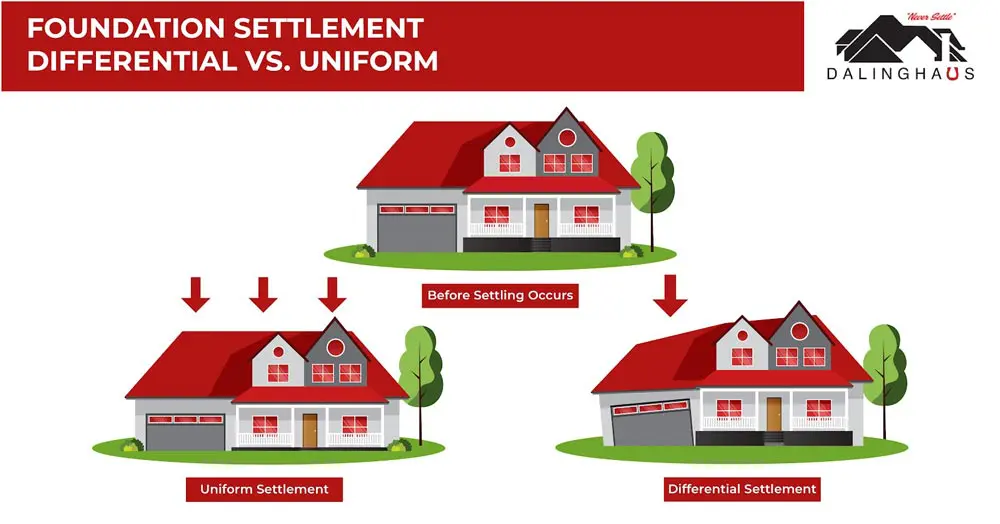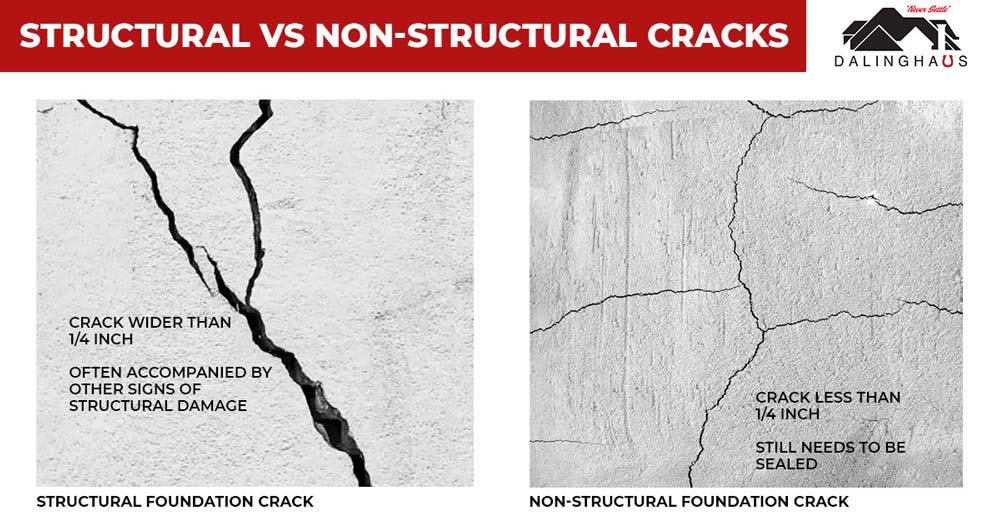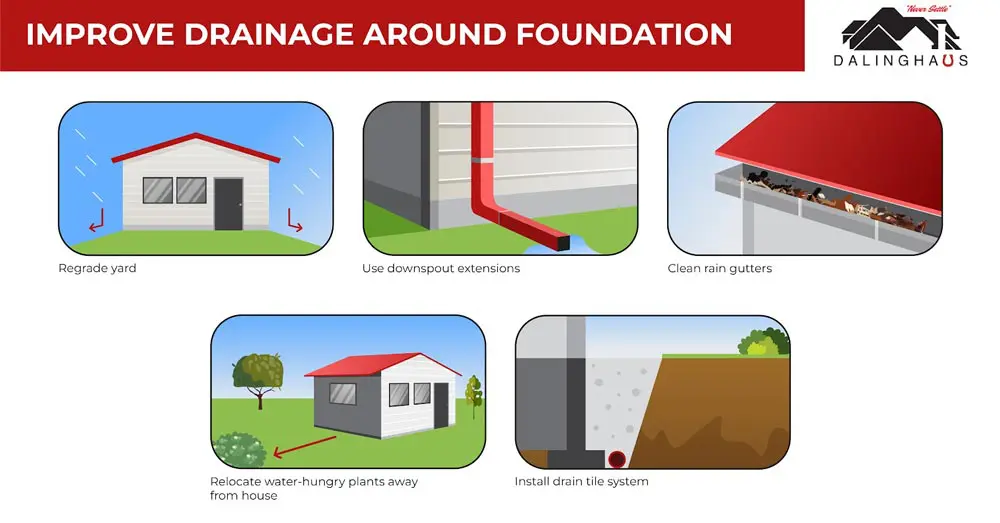If you’re searching for information about when a foundation is beyond repair, don’t hit that back button because you’ve landed on the right page. In this article, we’ll review the difference between structural and non-structural foundation cracks, foundation repair solutions, when a foundation is beyond repair and more.
What Is A Foundation Problem?
When we say a house has a foundation problem, we’re referring to any issues or defects that compromise the structural integrity of the foundation. Since the foundation bears the weight of the entire house and transfers it to the ground, any problems can lead to serious consequences, such as structural damage, safety hazards, and decreased property value.
What Causes Foundation Problems?
The most common cause of foundation problems is differential settlement, or when a foundation settles unevenly. Differential settlement puts enormous stress on a foundation, and if it isn’t promptly corrected, it can lead to severe structural damage.
So, the question is, what causes differential settlement?
Various things, including the following, cause differential settlement:
- Improper foundation construction – If the foundation wasn’t built to adequately support the structure’s weight or was constructed on unstable soil, it may begin to settle into the ground unevenly over time.
- Expansive clay soil – Soil with a high percentage of clay expands and contracts with changes in moisture levels. This back and forth, swelling and shrinking, creates movement under the foundation, which can lead to differential settlement.
- Erosion-prone soil – Some types of soil are prone to erosion. If this happens, voids can form beneath the foundation. If the foundation settles into the voids, there will be differential settlement.
- Tree roots – Trees with extensive root systems planted too close to the foundation can cause serious trouble when the roots push against the foundation’s walls, work their way into cracks, and cause issues with the soil under the foundation. Keep trees at least 15 feet away from the foundation.

Common Signs Your Home’s Foundation Might Have a Problem
The most common signs your home might have a foundation issue include the following:
- The most obvious sign of foundation problems is the appearance of cracks in walls, floors, and ceilings. These cracks are not just cosmetic but can indicate significant structural issues. Usually, vertical cracks are less of a concern than horizontal ones. Horizontal and stair-step cracks indicate serious foundation issues that require immediate attention. We’ll have more to say on cracks in just a bit.
- Another symptom of foundation problems is doors and windows that stick and are difficult to open or close. This happens because the foundation is uneven, causing everything to be out of plumb. If you notice difficulty opening or closing doors and windows, it’s essential to investigate the root cause and fix the issue promptly.
- Uneven flooring is another sign of foundation problems. When the foundation isn’t level, the floors will become uneven. This can cause tripping hazards or even damage to furniture and appliances.
If you see any of the above – or anything else that seems suspicious – contact a qualified foundation repair contractor immediately and ask for a foundation evaluation.
Structural vs. Non-structural Cracks
When it comes to foundation cracks, it’s essential to understand that not all cracks are created equal. There are two categories of foundation cracks: structural and non-structural. Understanding the difference between the two can help homeowners determine whether they need to take immediate action or if the crack can wait for repair.
Structural foundation cracks
Structural foundation cracks are the more serious of the two. These are cracks that affect your home’s structural integrity, and they should be addressed immediately. Examples of structural foundation cracks include cracks that are wider than ¼ inch, horizontal, diagonal, or stair-step cracks, and cracks that are accompanied by other signs of structural damage, such as uneven floors or doors that don’t close properly.
Non-structural foundation cracks
Non-structural foundation cracks, on the other hand, are smaller and less concerning. Examples of non-structural foundation cracks include vertical hairline cracks that are less than ¼ inch wide. They often occur due to shrinkage during the concrete curing process and are not a threat to the structure’s overall stability. However, they can allow water to seep through a foundation wall and into a basement or crawl space. Therefore, they should be sealed.

The Good News Is Most Foundation Problems Can Be Fixed
The good news is most foundation problems can be fixed, and rarely is a foundation beyond repair. Various repair methods can be used to fix foundation problems, including underpinning using push or helical piers, carbon fiber wall straps, and wall anchors.
It’s important to address foundation problems sooner rather than later. If you ignore a foundation problem, it will worsen, and you’ll pay more for the repair.
For more information, see What Is A Foundation Pier?
When Is a Foundation Beyond Repair?
When a foundation is determined to be beyond repair, it typically means that the structural integrity of the building has been compromised to such an extent that it wouldn’t make sense economically to repair the foundation. This can occur for various reasons, including a catastrophic natural disaster or a long-neglected foundation problem. In other words, a foundation needs to be in really bad condition before it’s beyond repair. As we noted above, most foundations can be repaired.
Determining when a foundation is beyond repair requires a thorough inspection by a qualified engineer or contractor. They will evaluate the extent of the damage, the underlying causes, and the potential risks associated with repairing or replacing the foundation.
How to Prevent Foundation Problems
Since most foundation problems are caused by water, homeowners can go a long way toward preventing issues simply by controlling groundwater around the foundation. Here are some ways to do that:
- Keep your gutters clean and debris-free. When gutters become clogged, water can overflow and seep into the ground around the foundation, causing problems.
- Install downspout extensions. These will direct runoff away from the foundation before release.
- Re-grading the yard around the home can also help prevent foundation issues. Ensuring the ground slopes away from the house rather than toward it allows groundwater to flow away from the foundation.
- Installing a drain tile system can be an effective preventative measure for foundation problems. This involves excavating around the foundation and installing perforated pipes that redirect water away from the foundation.

How Much Does Foundation Repair Cost?
The cost of repairing your foundation can be influenced by factors such as your location, the severity of the problem, and the type of repair needed. For example, if you live in an area with a high demand for foundation repair services, you may find that the cost of repairs is higher than in other areas. Similarly, if the problem with your foundation is severe and requires a more complex repair solution, you may need to pay more for the repair job. To better understand how much a foundation repair job will cost, you’ll need to contact a professional foundation repair contractor. For more information, see Foundation Repair Cost.
If you’re concerned about your home’s foundation and wondering if it’s beyond repair, contact us today to schedule a foundation evaluation. We serve Southern California, Arizona, and Nevada.






